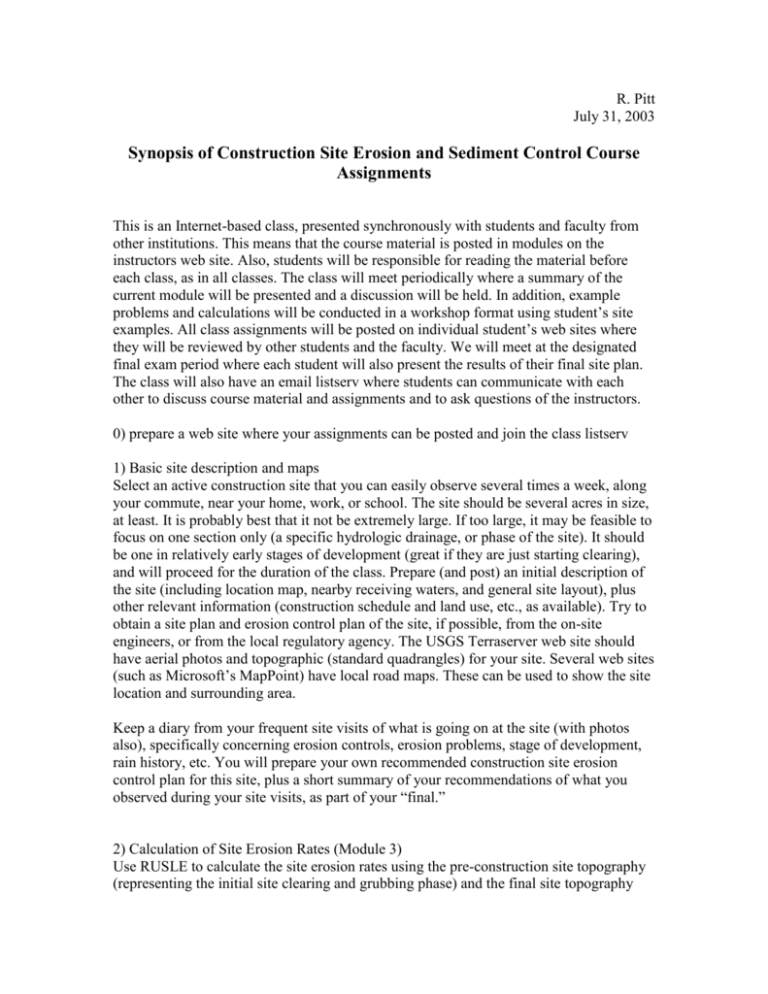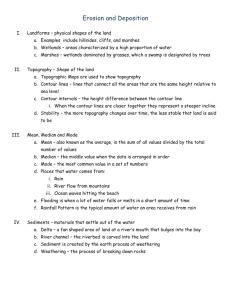Synopsis of Construction Site and Erosion Control Assignments
advertisement

R. Pitt July 31, 2003 Synopsis of Construction Site Erosion and Sediment Control Course Assignments This is an Internet-based class, presented synchronously with students and faculty from other institutions. This means that the course material is posted in modules on the instructors web site. Also, students will be responsible for reading the material before each class, as in all classes. The class will meet periodically where a summary of the current module will be presented and a discussion will be held. In addition, example problems and calculations will be conducted in a workshop format using student’s site examples. All class assignments will be posted on individual student’s web sites where they will be reviewed by other students and the faculty. We will meet at the designated final exam period where each student will also present the results of their final site plan. The class will also have an email listserv where students can communicate with each other to discuss course material and assignments and to ask questions of the instructors. 0) prepare a web site where your assignments can be posted and join the class listserv 1) Basic site description and maps Select an active construction site that you can easily observe several times a week, along your commute, near your home, work, or school. The site should be several acres in size, at least. It is probably best that it not be extremely large. If too large, it may be feasible to focus on one section only (a specific hydrologic drainage, or phase of the site). It should be one in relatively early stages of development (great if they are just starting clearing), and will proceed for the duration of the class. Prepare (and post) an initial description of the site (including location map, nearby receiving waters, and general site layout), plus other relevant information (construction schedule and land use, etc., as available). Try to obtain a site plan and erosion control plan of the site, if possible, from the on-site engineers, or from the local regulatory agency. The USGS Terraserver web site should have aerial photos and topographic (standard quadrangles) for your site. Several web sites (such as Microsoft’s MapPoint) have local road maps. These can be used to show the site location and surrounding area. Keep a diary from your frequent site visits of what is going on at the site (with photos also), specifically concerning erosion controls, erosion problems, stage of development, rain history, etc. You will prepare your own recommended construction site erosion control plan for this site, plus a short summary of your recommendations of what you observed during your site visits, as part of your “final.” 2) Calculation of Site Erosion Rates (Module 3) Use RUSLE to calculate the site erosion rates using the pre-construction site topography (representing the initial site clearing and grubbing phase) and the final site topography (representing the final site conditions). Preferably, these should be based on detailed topographic maps obtained from the on-site engineers. Assume a “C” factor of 1 (uncontrolled) and a “P” factor of 1 (not considering agricultural site practices, obviously). Using the site plans, identify areas associated with each category of erosion hazard. You may also want to further identify separate areas corresponding to functional site areas (such as parking areas, terraces, roadway cut areas, slopes along roads, etc.) that will likely have separate erosion controls applied. Describe the most critical site areas and compare the site calculated erosion rates with literature and regional erosioin values. 3) Site Hydrology (Module 4) Use WinTR-55 (but do some checks using TR-55 tabular hydrograph methods) to evaluate upslope and onsite hydrologic conditions. Divide your area into subdrainage areas corresponding to different functions, and select appropriate design rainfall amounts for the appropriate failure rates for each. For upslope areas, determine the drainage areas needed for diversion swales or channels to divert this upslope water either around the site, or towards major on-site drainages (designated on the topo map, for example). You may not have any upslope contributing areas if a nearby existing drainage along a major road already intercepts the flows, or if you are on the top of a hill. If a nearby road appears to intercept the flows, conduct a site investigation to make sure that no culverts direct the water onto your site. Divide on-site areas into subdrainages directed to perimeter filter fences, and to site ponds. Also examine on-site slopes where slope protection may be needed (also determine the expected sheetflow water depths for the slopes for the appropriate design storm). Also, examine the area downslope from the perimeter filter fences and site ponds to investigate the immediate areas of influence adjacent to your site. 4) Channel and Slope Stability (Module 5) Design the appropriate diversion channels for the upslope edges of the site, and any onsite major drainages for capacity (according to the appropriate design storm) and for stability. Remember to also add in the “natural” flows entering the major on-site drainage, and not just the diverted water. Use WinTR-55 to determine the combined hydrograph and peak flow for any on-site channel. Also examine the site slopes and identify slope protection options, including their resulting erosion rates (after protection). 5) Sediment Ponds and Filter Fences (Module 6) Design a temporary sediment pond for your site. Your site may be too small to “require” a sediment pond, but do the calculations anyways so you can make the decision later if it is needed. Locate the pond at the most appropriate area and use WinTR-55 to determine the inflow hydrograph for the appropriate design storm. Make sure you consider sacrificial sediment storage and select appropriate outlet controls (including an emergency spillway, probably a rectangular weir, selected using Chapter 6 procedures in TR55). If possible, use WinTR-55 to route the design storm through the pond. Also, determine the needed locations for on-site and perimeter filter fences. Design and evaluate these filter fences. If possible, use WinTR-55 or WinDETPOND to evaluate the filter fences for the design storms. 6) Vegetation Controls (Module 7) Select (and justify) the vegetation for different site areas and construction phases. What likely soil preparation and amendments will be needed for your site? Calculate the resulting erosion rates using RUSLE for the vegetated site conditions. Review the channel designs previously conducted in assignment 4 and use the material in this module to select an appropriate vegetated lining system. 7) Other Structural Controls (Module 8) Identify the types and locations of appropriate additional structural controls needed for your site. Discuss how they will function and what back-up systems will be present in case these do not function as intended. 8) Final Erosion and Sediment Control Plan (Final Exam) Submit the final site erosion and sediment control plan for your site, along with your site visit diary. The plan must consider different construction phases for your site (areas disturbed, durations, temporary and permanent controls). Use the guidance in Modules 1 and 2 in developing the plan. Although you have already completed many of the calculations and other design elements in previous assignments, you will need to make suitable revisions for the different phases and to focus only on the controls that will be selected for each phase in your final plan. Calculate the site erosion rates for each construction phase and discuss the robustness of your selected practices (individually and acting together). Estimate the costs for the plan implementation, using the material in Module 2. Prepare and present a PowerPoint presentation of your site and final plan. Each student will have 15 minutes for their presentation, and there will be an opportunity for questions from the class and discussion. All of your web site material is also to be submitted on a CD-ROM, with the knowledge that selected material may be used in future classes and possibly posted on the course web site.







